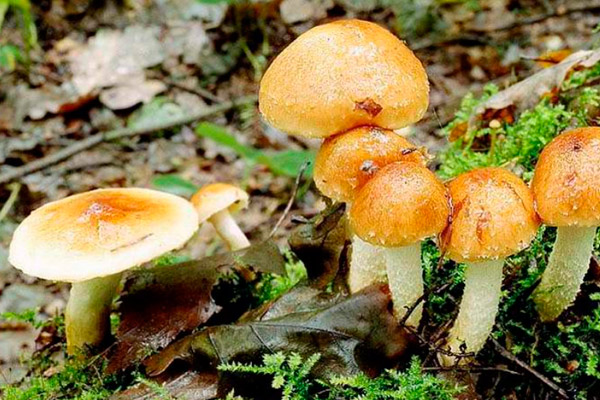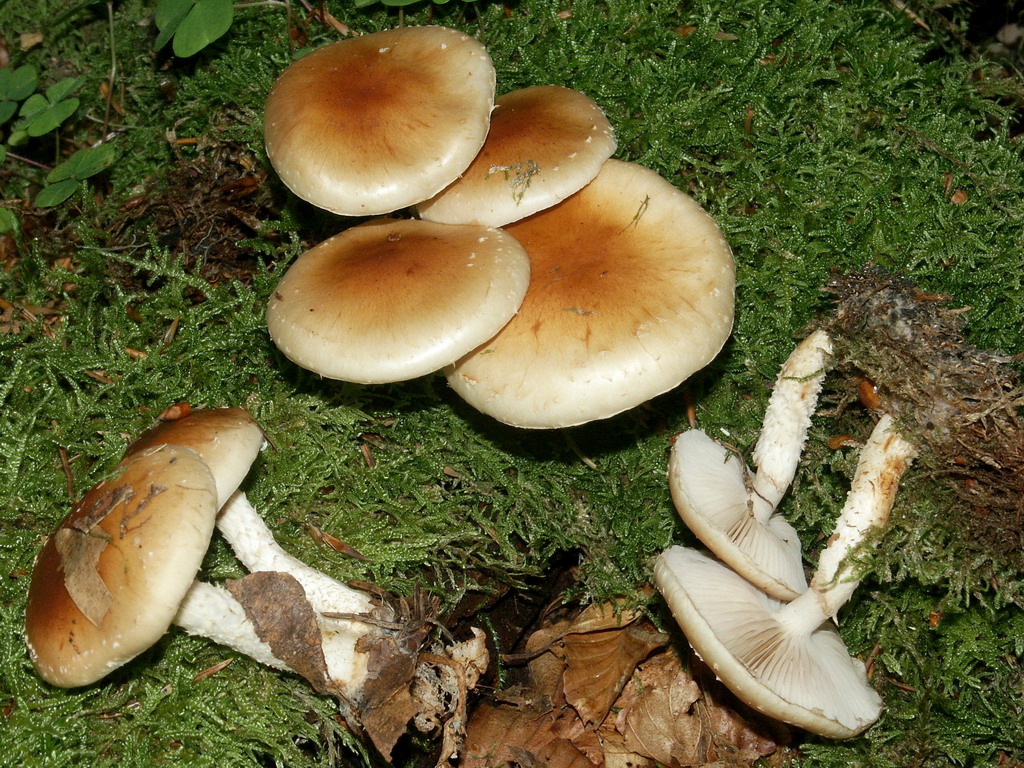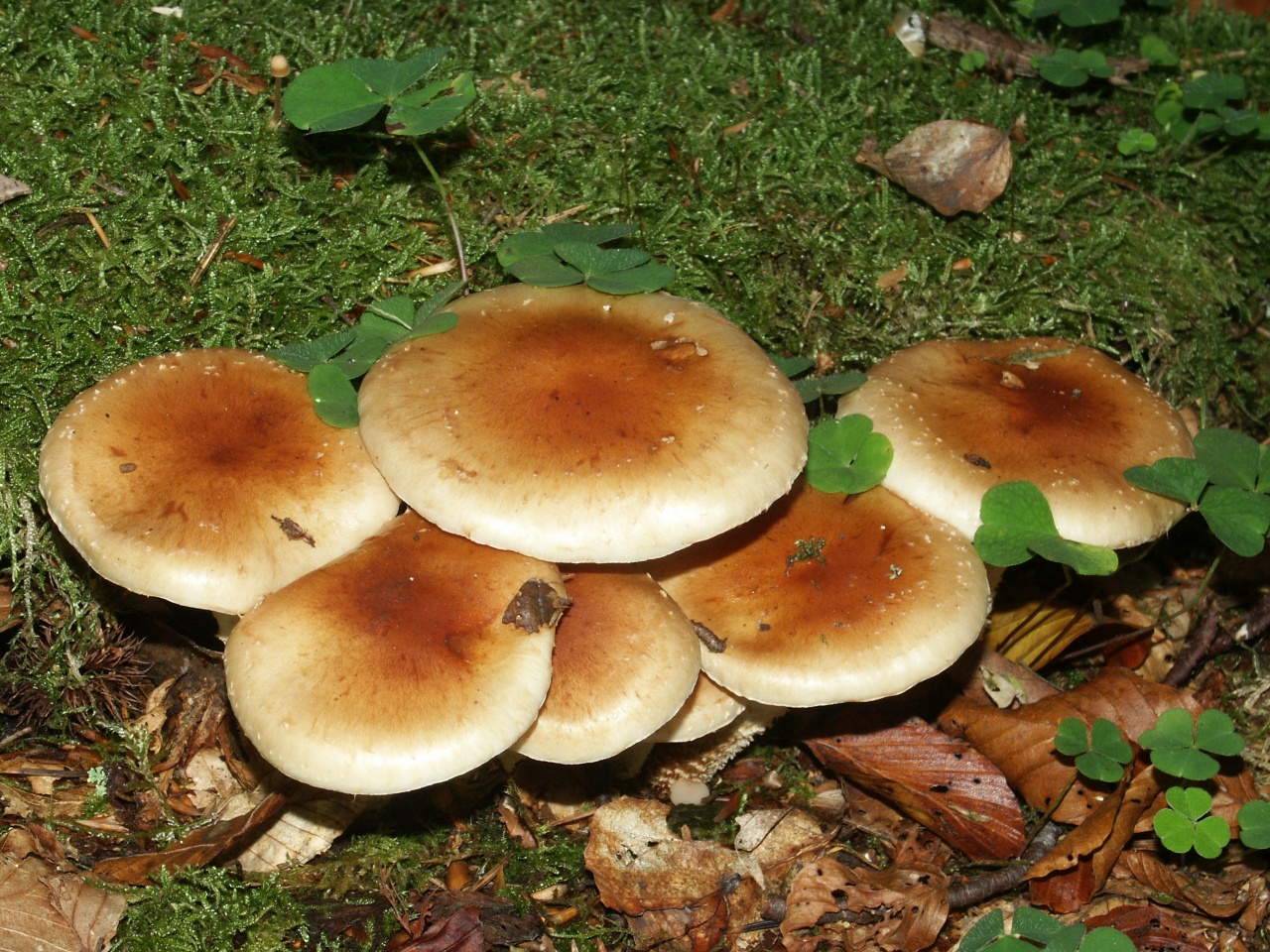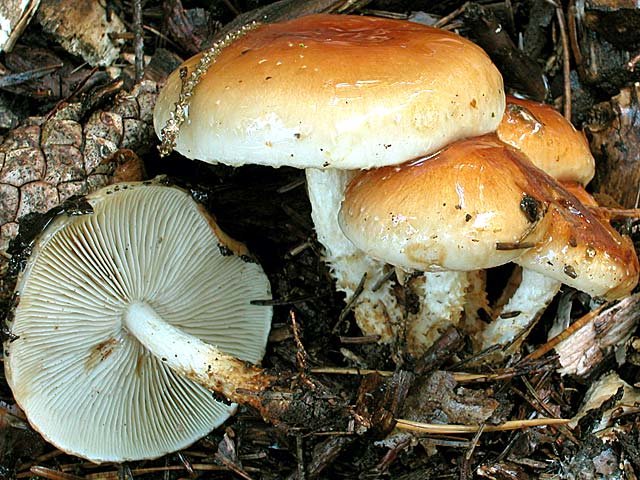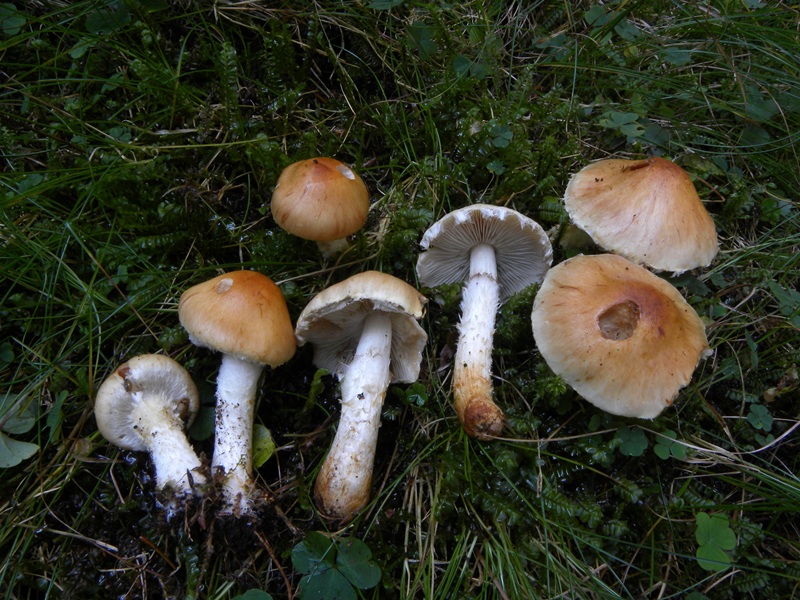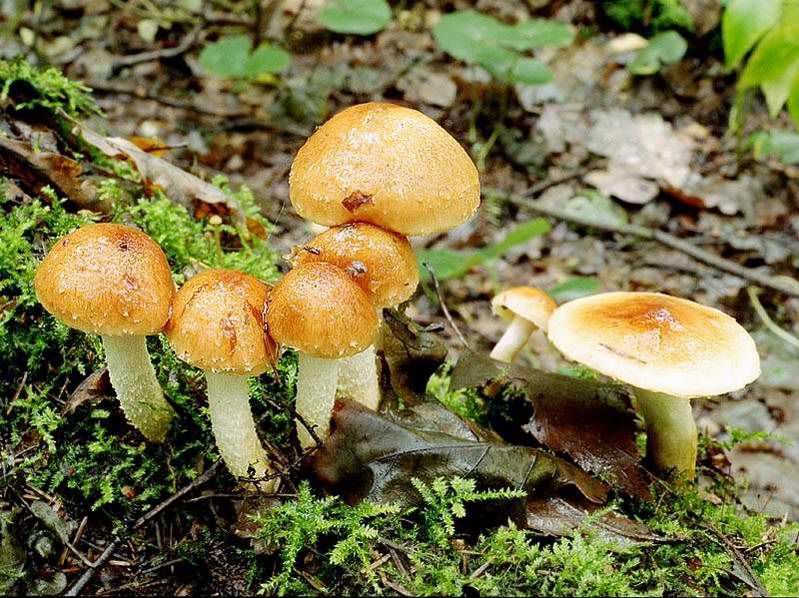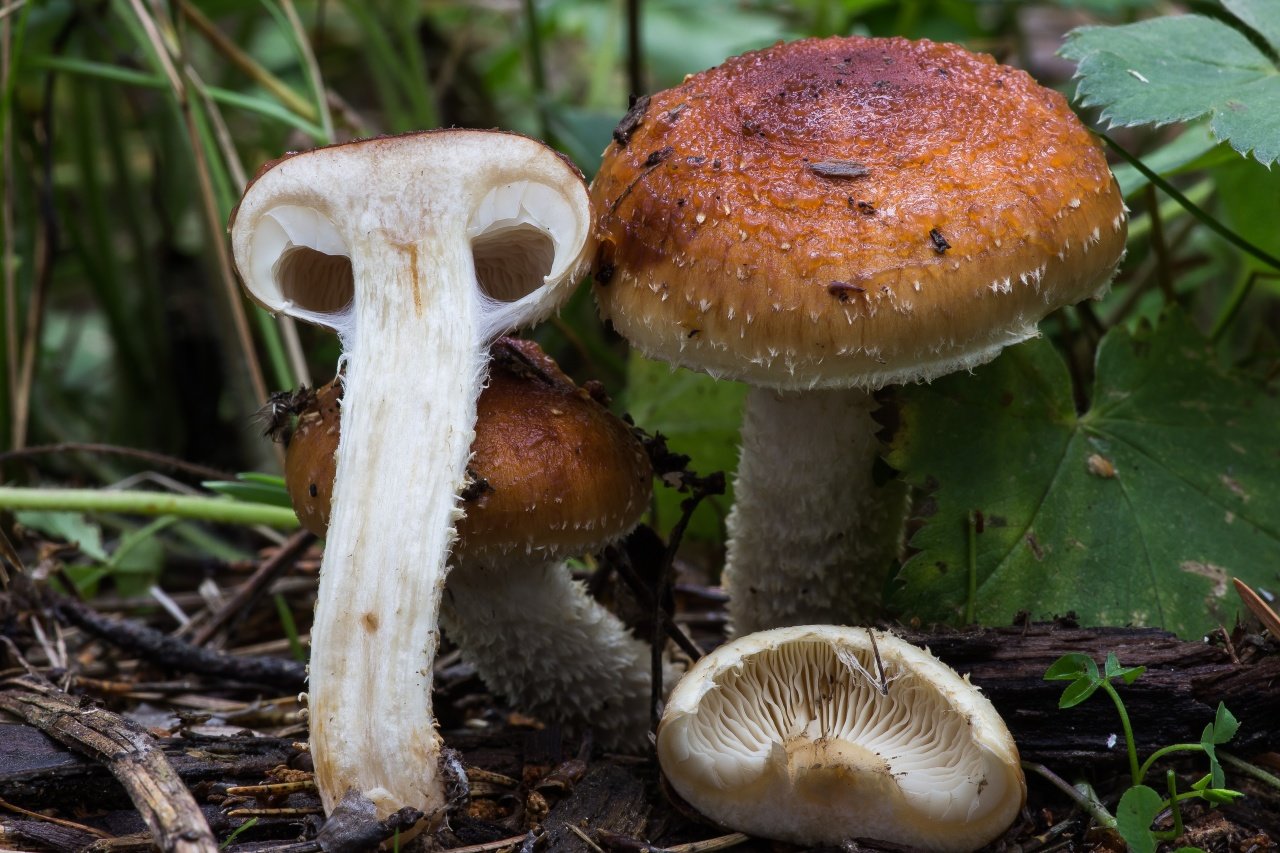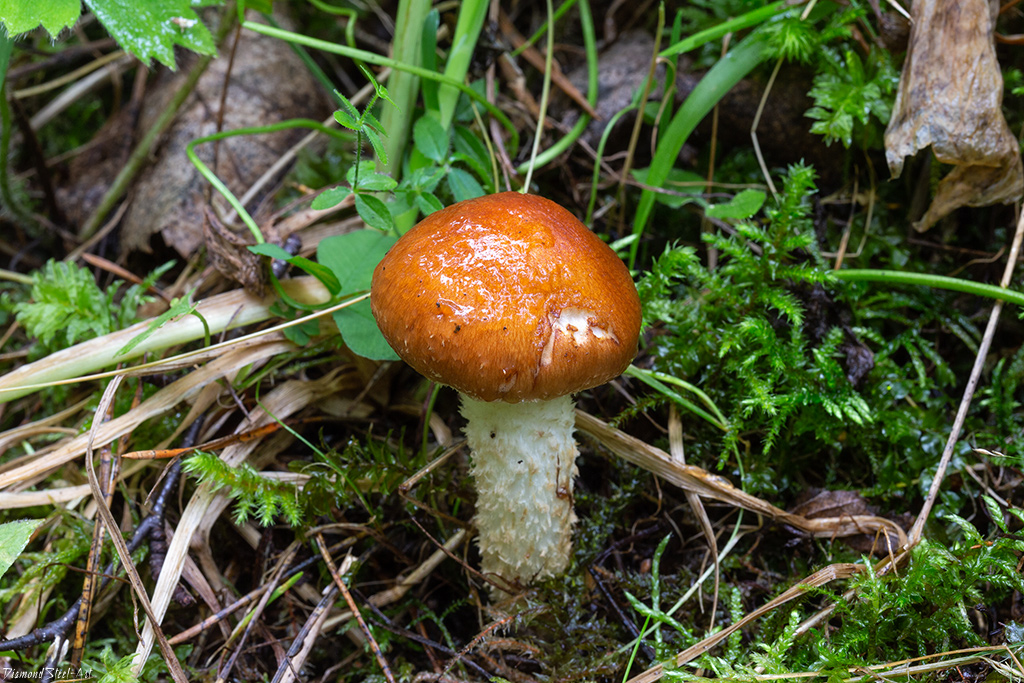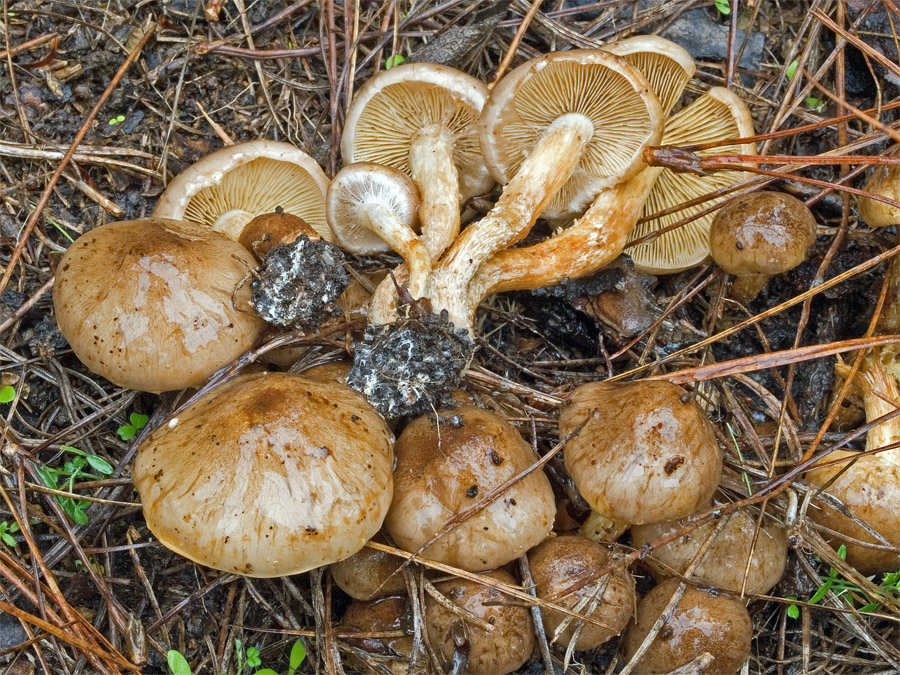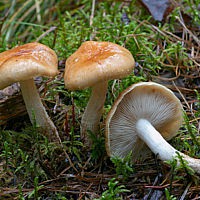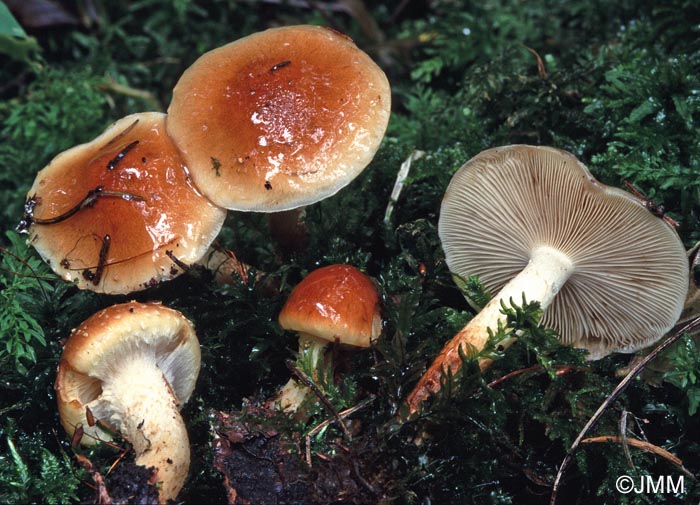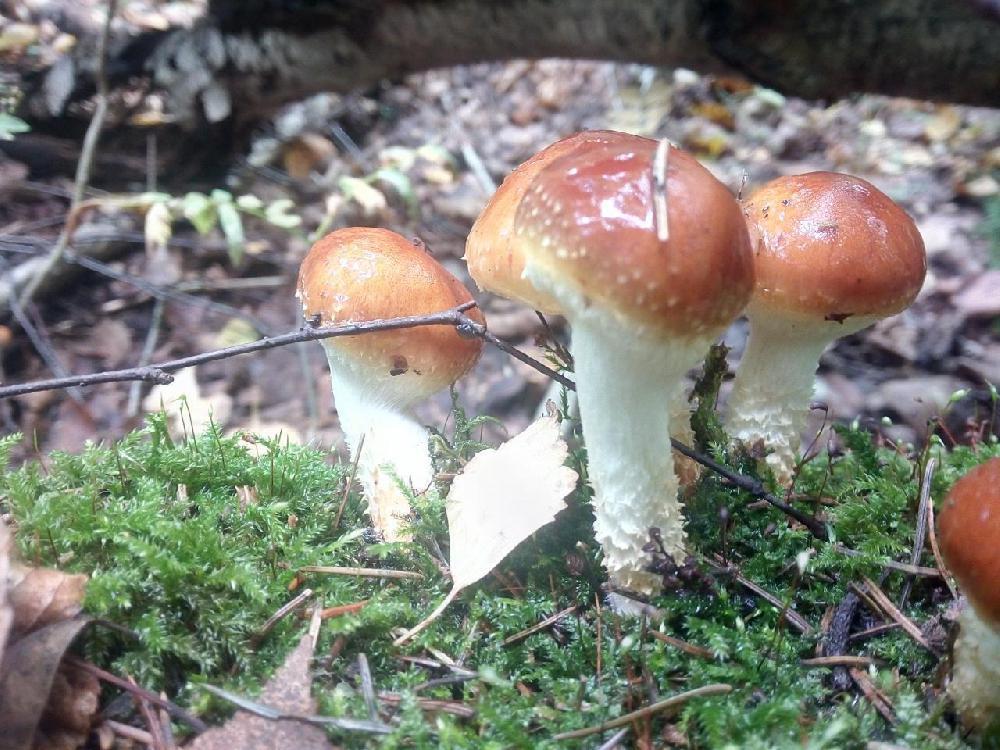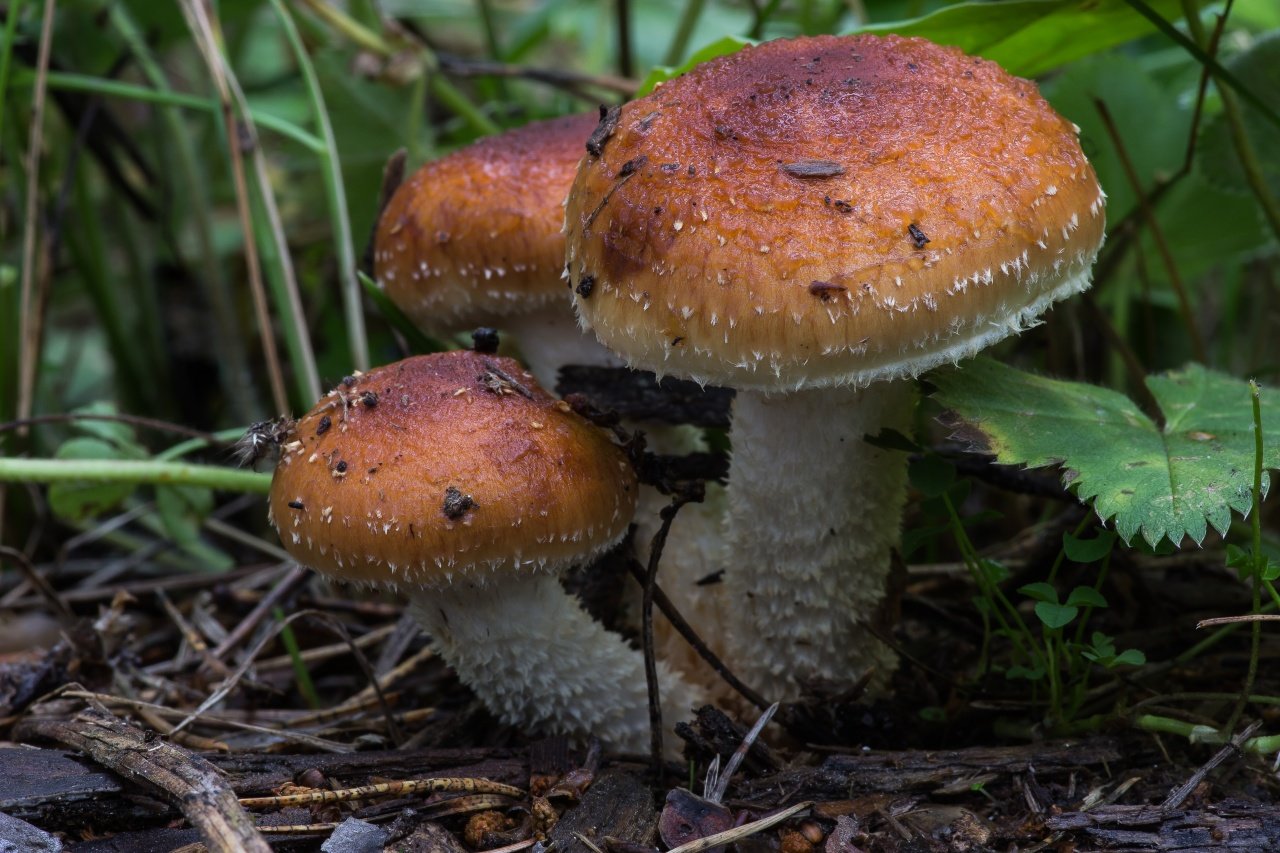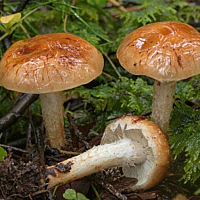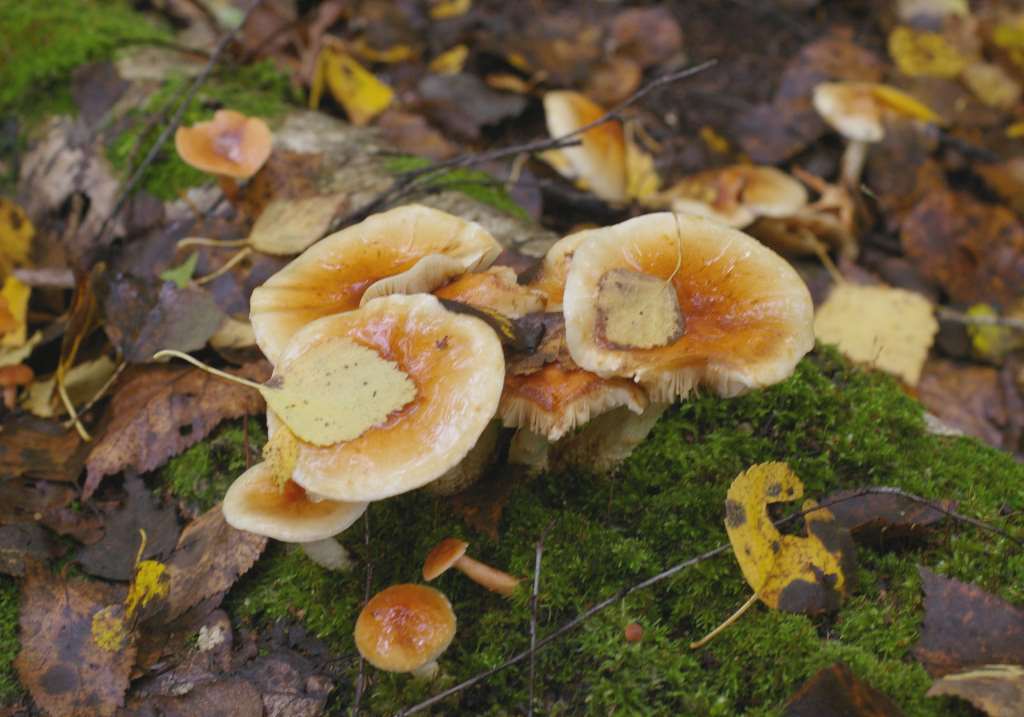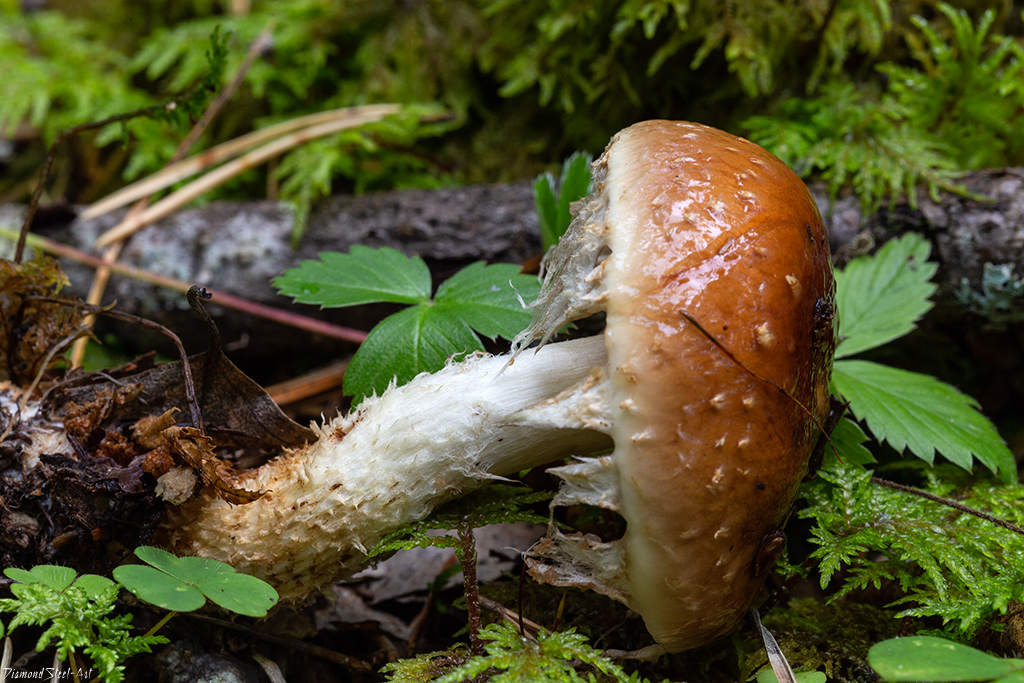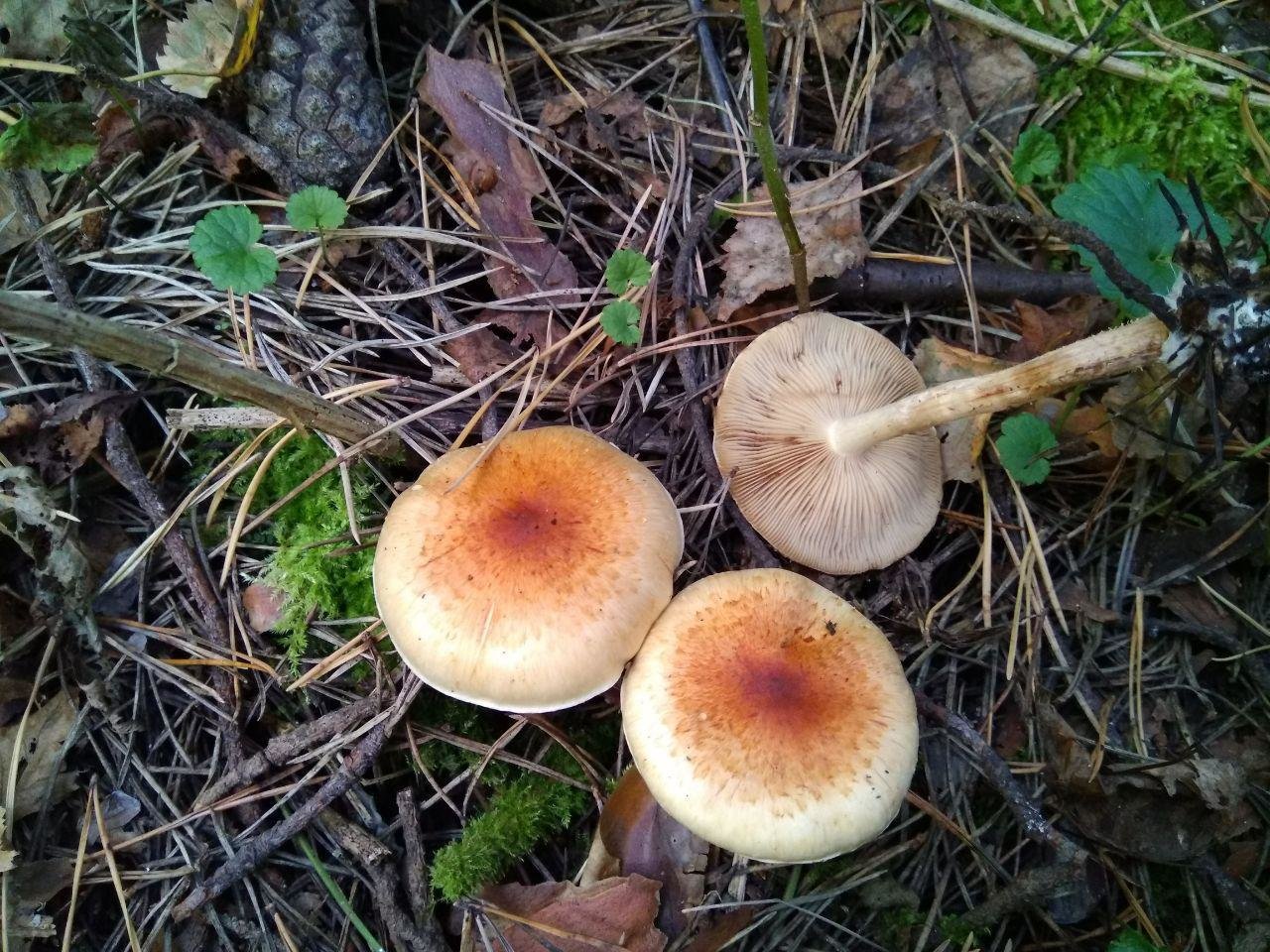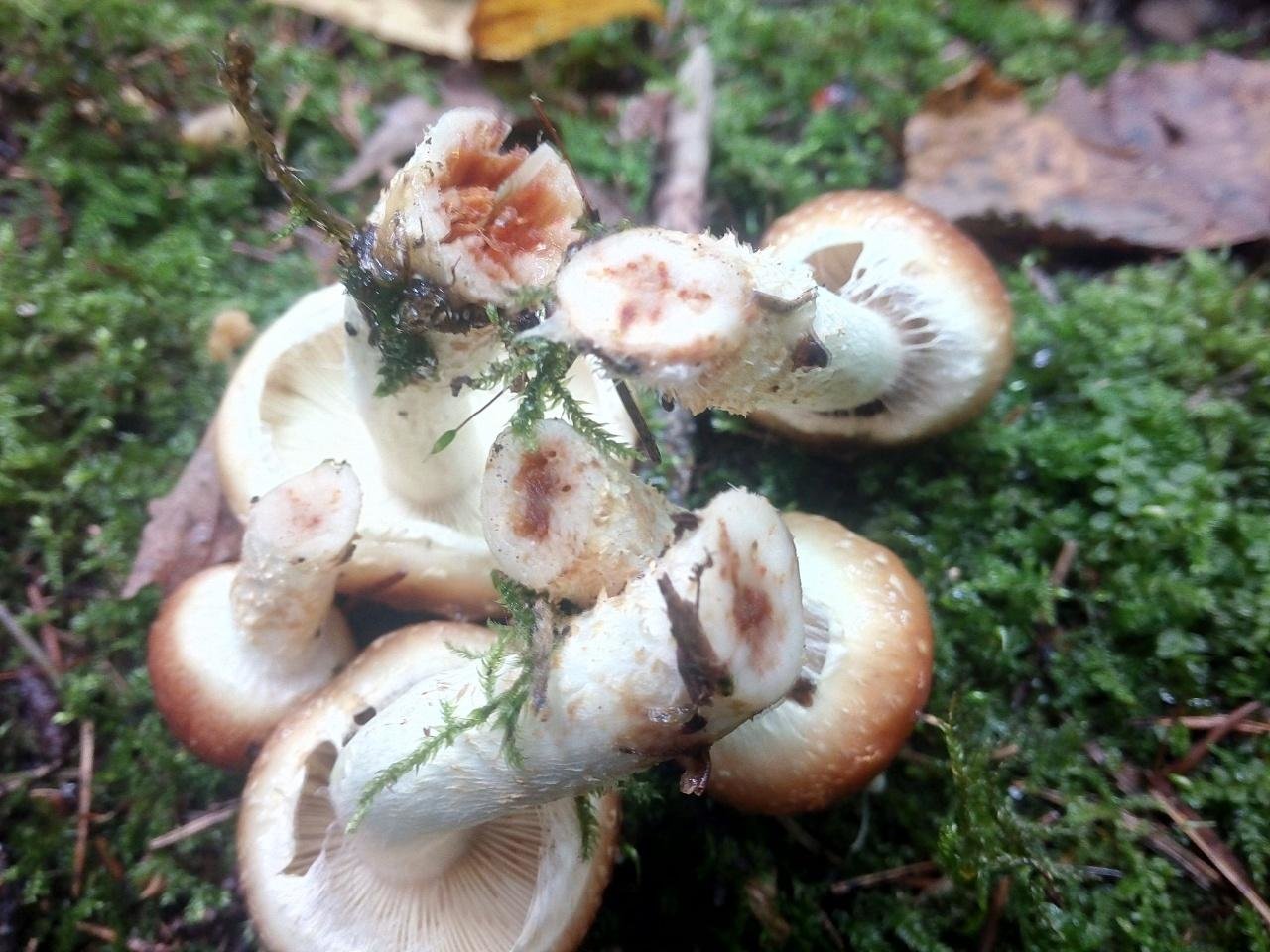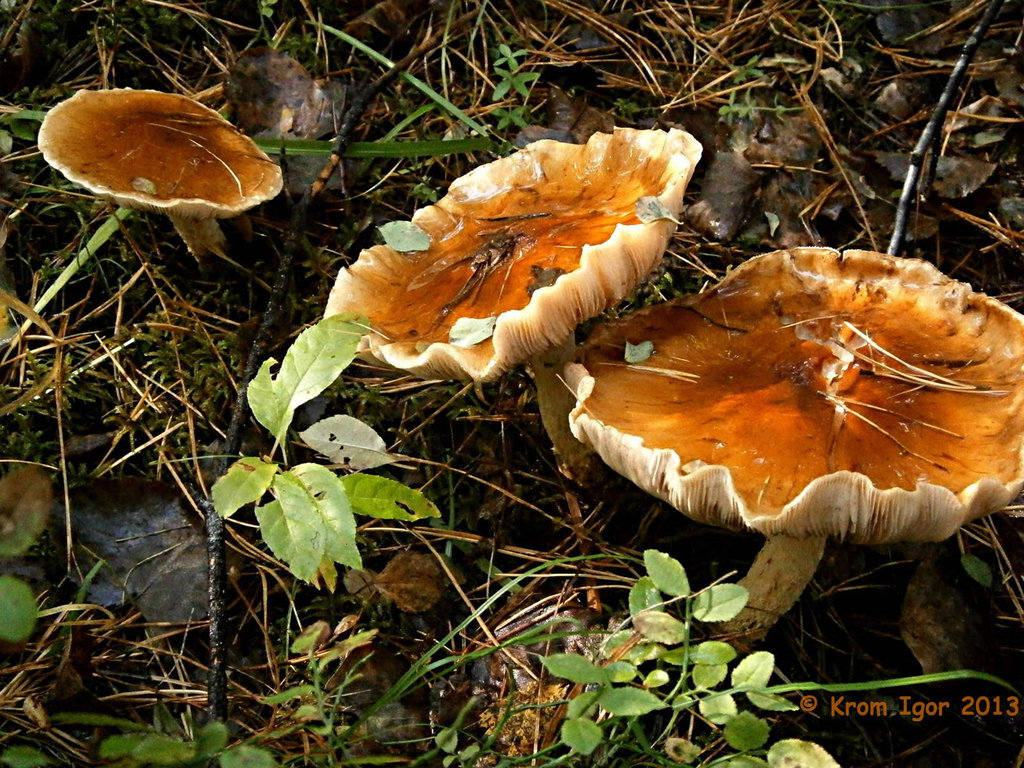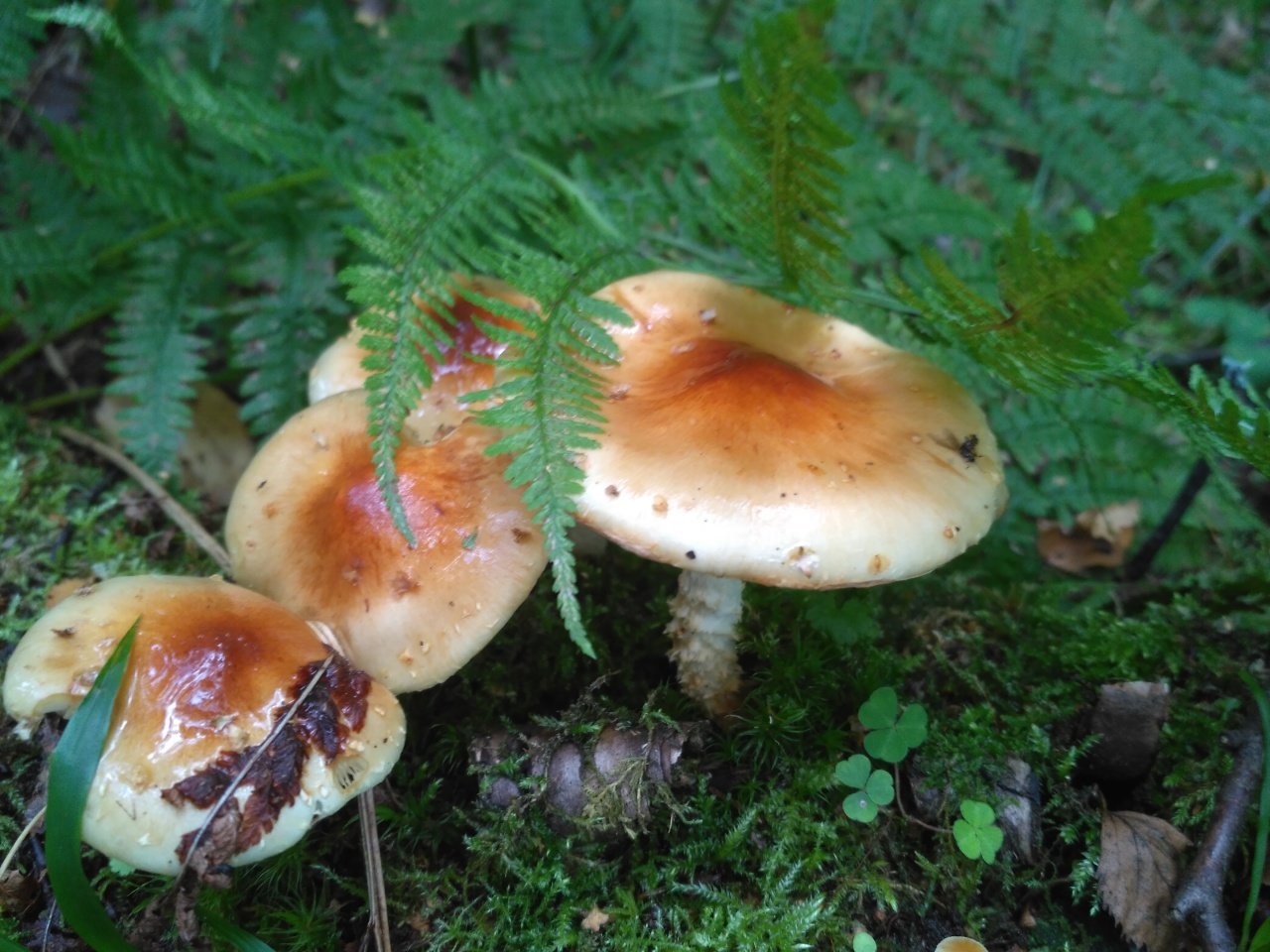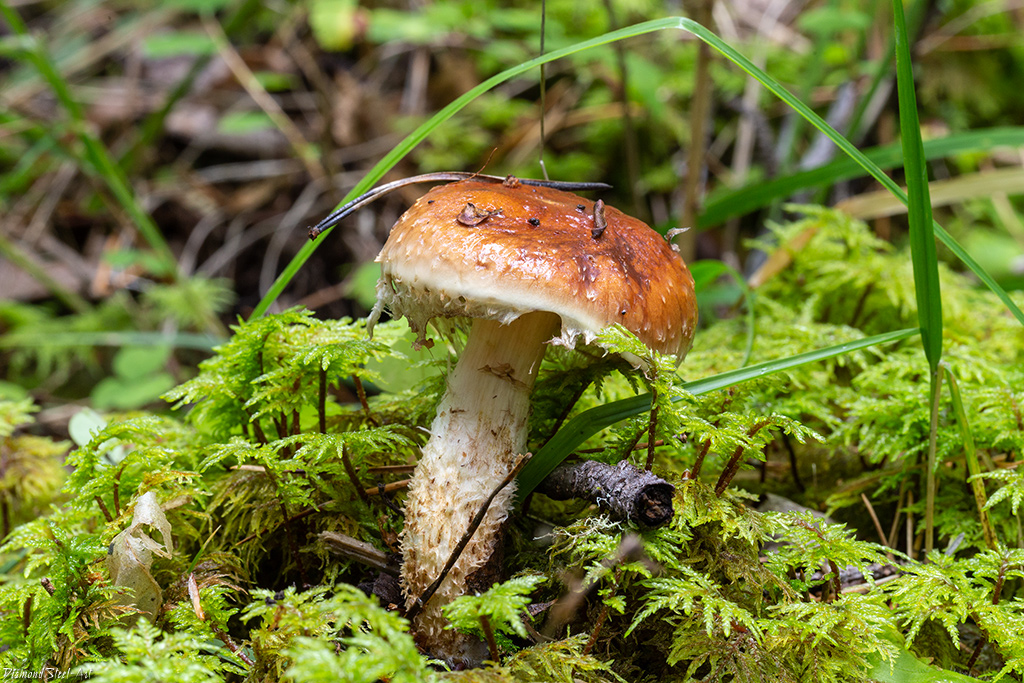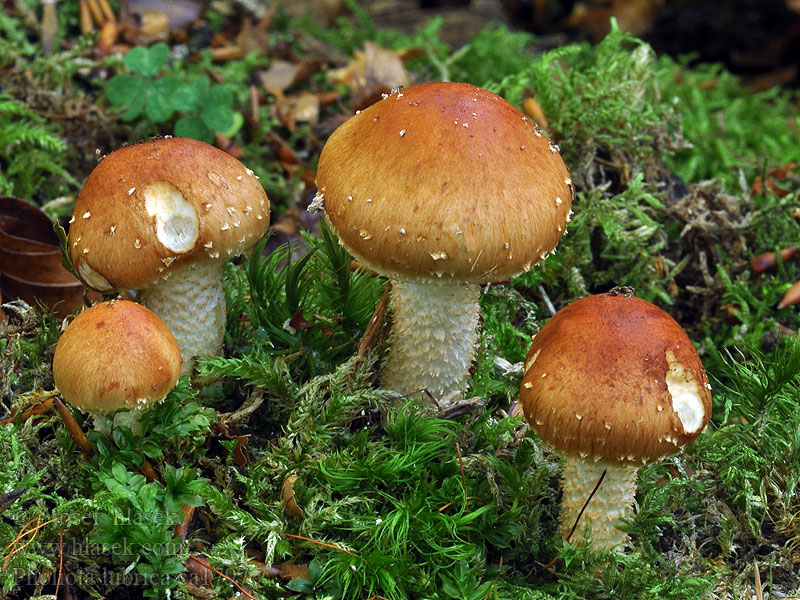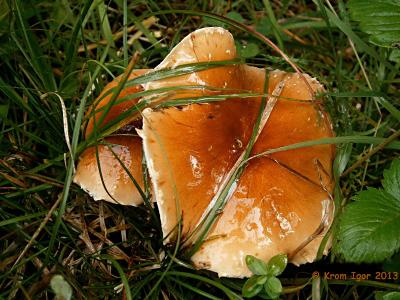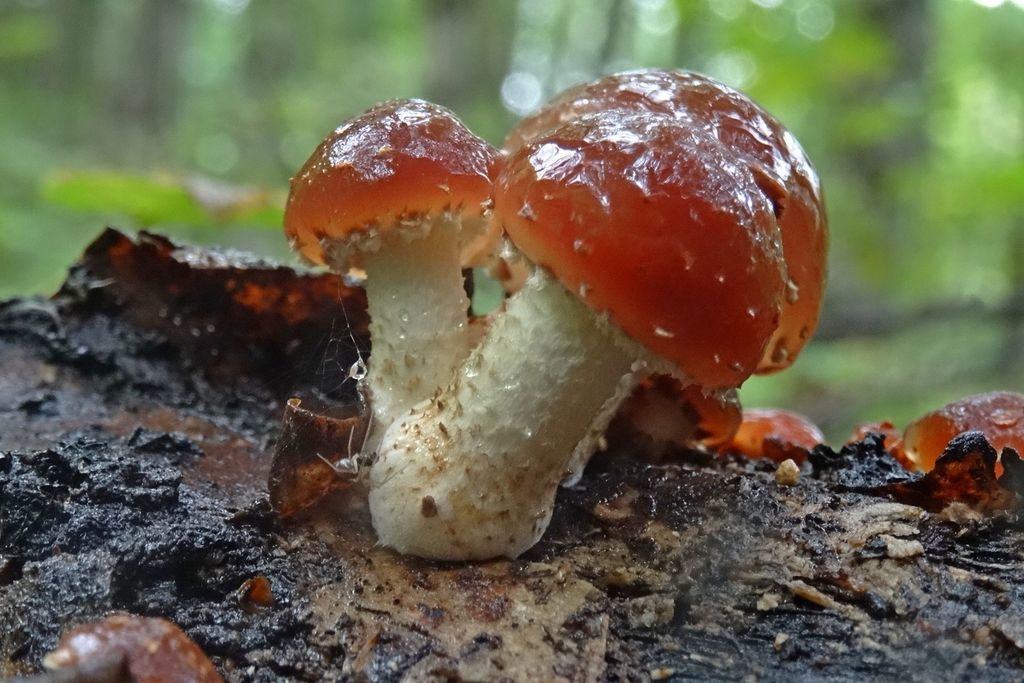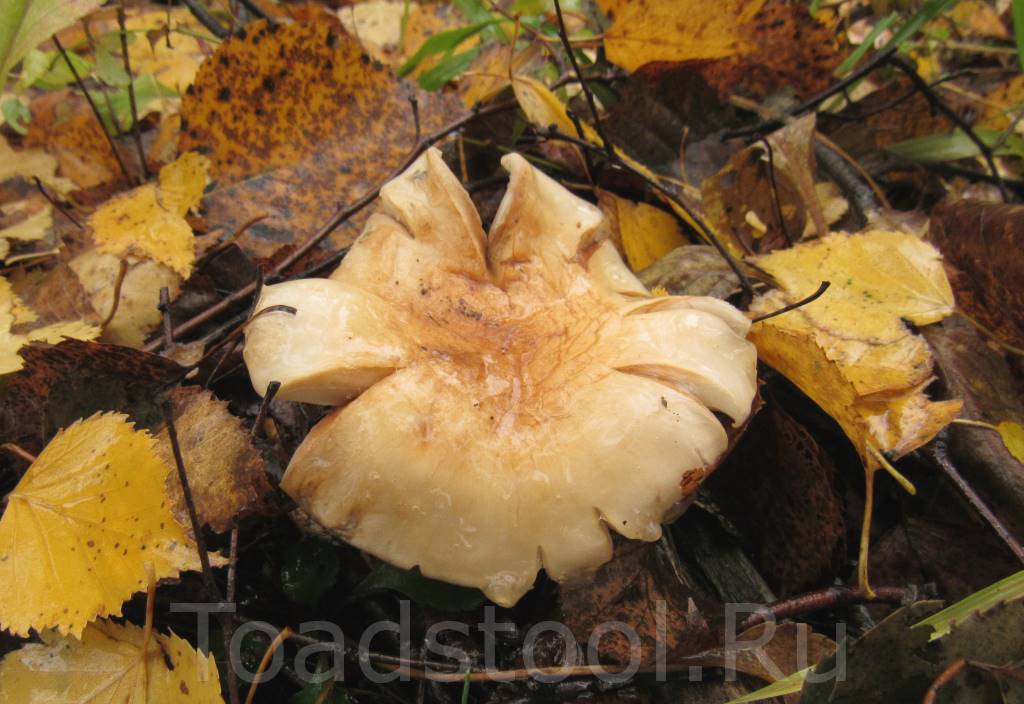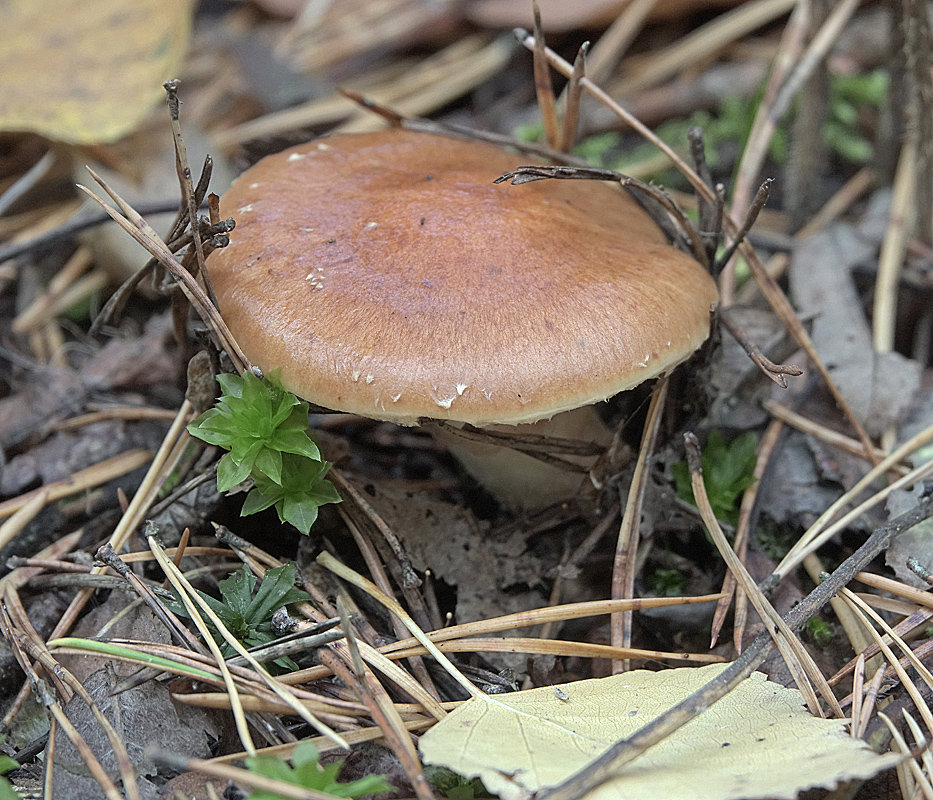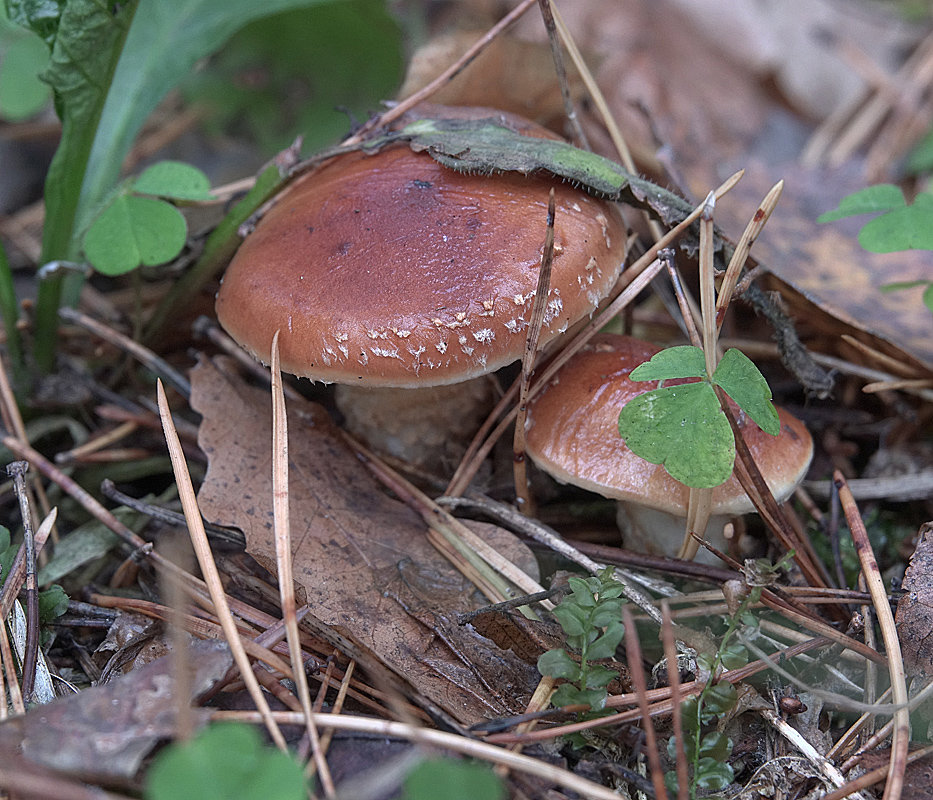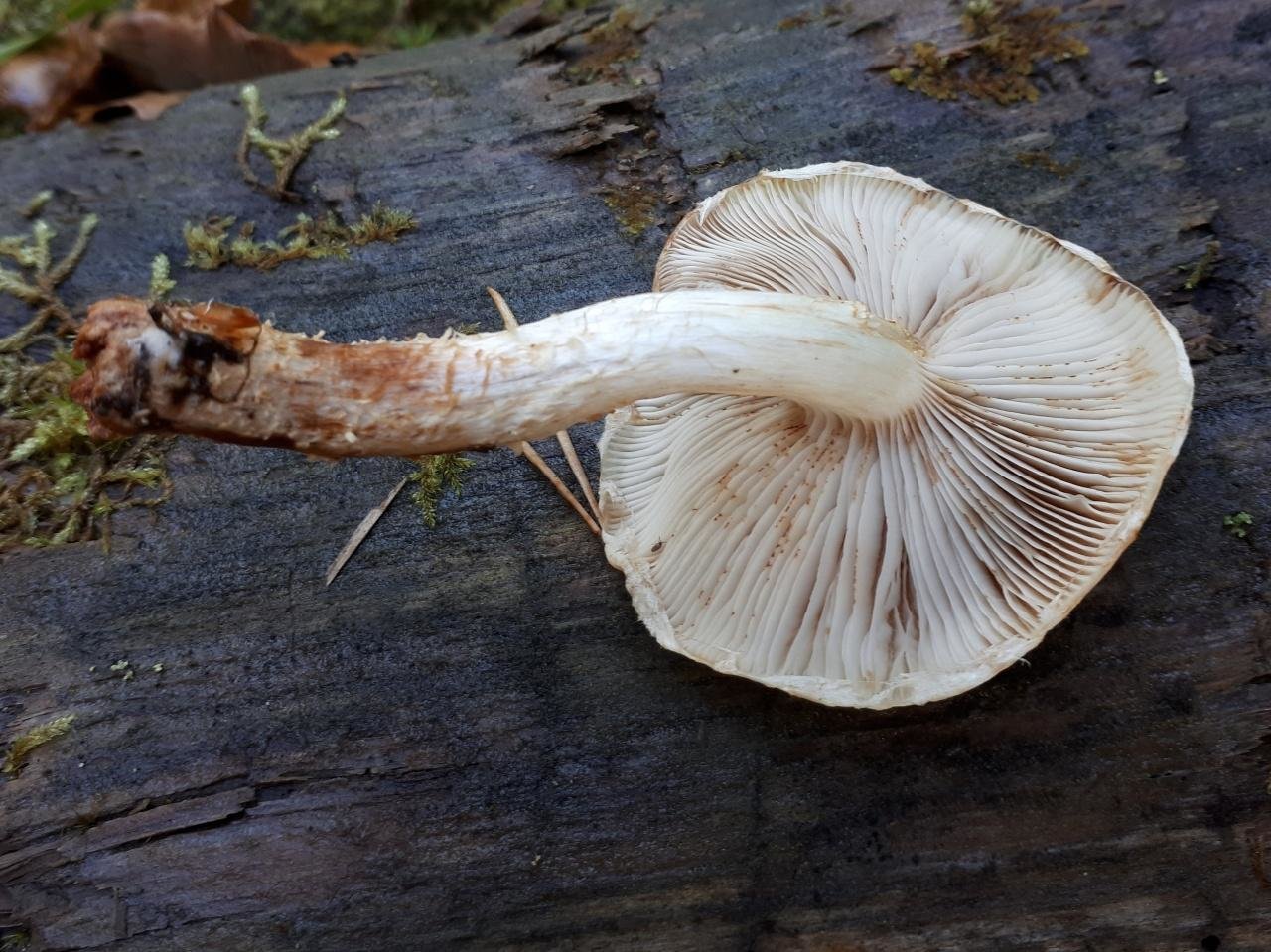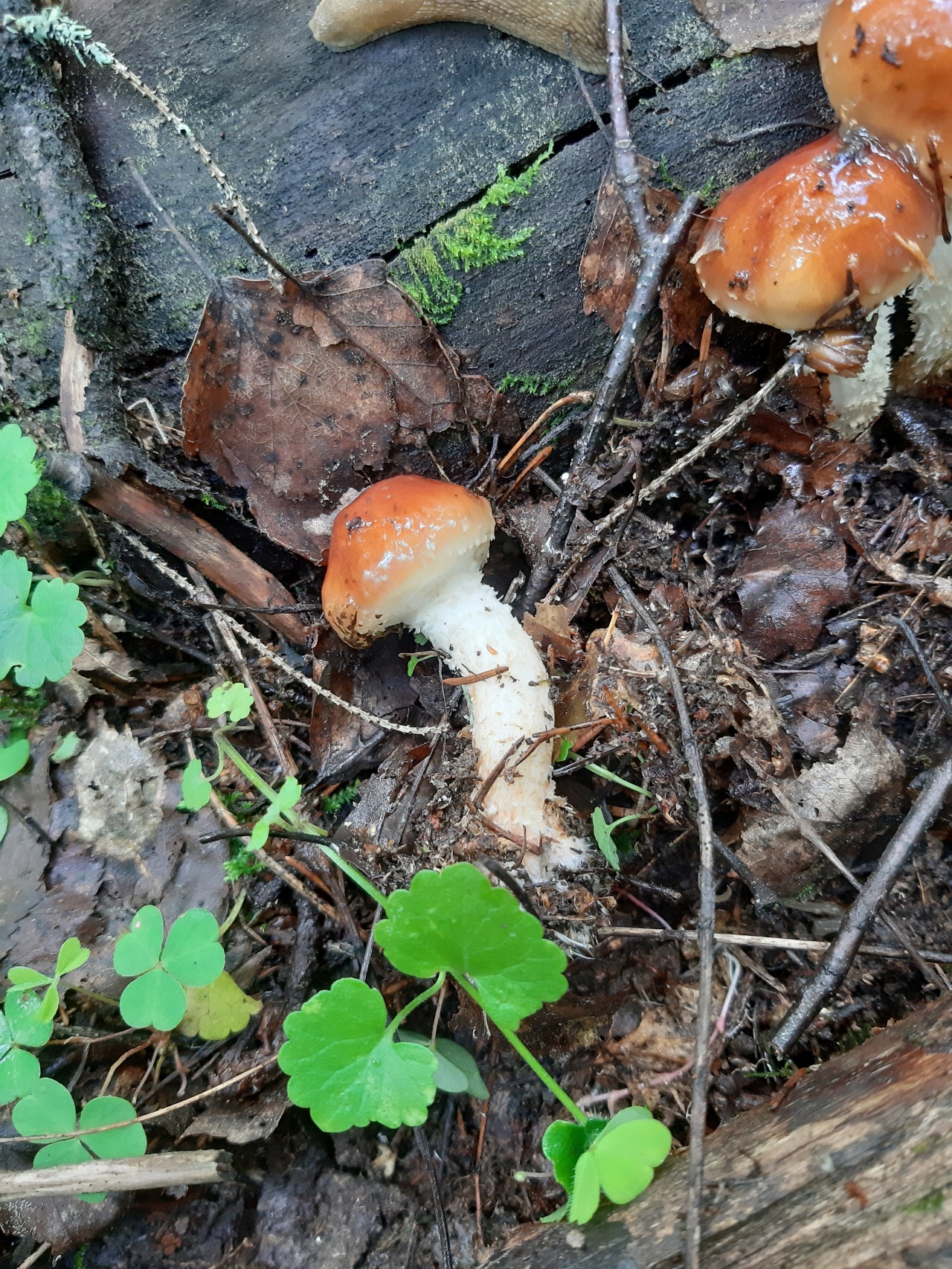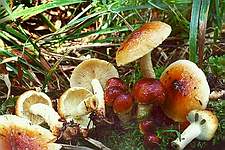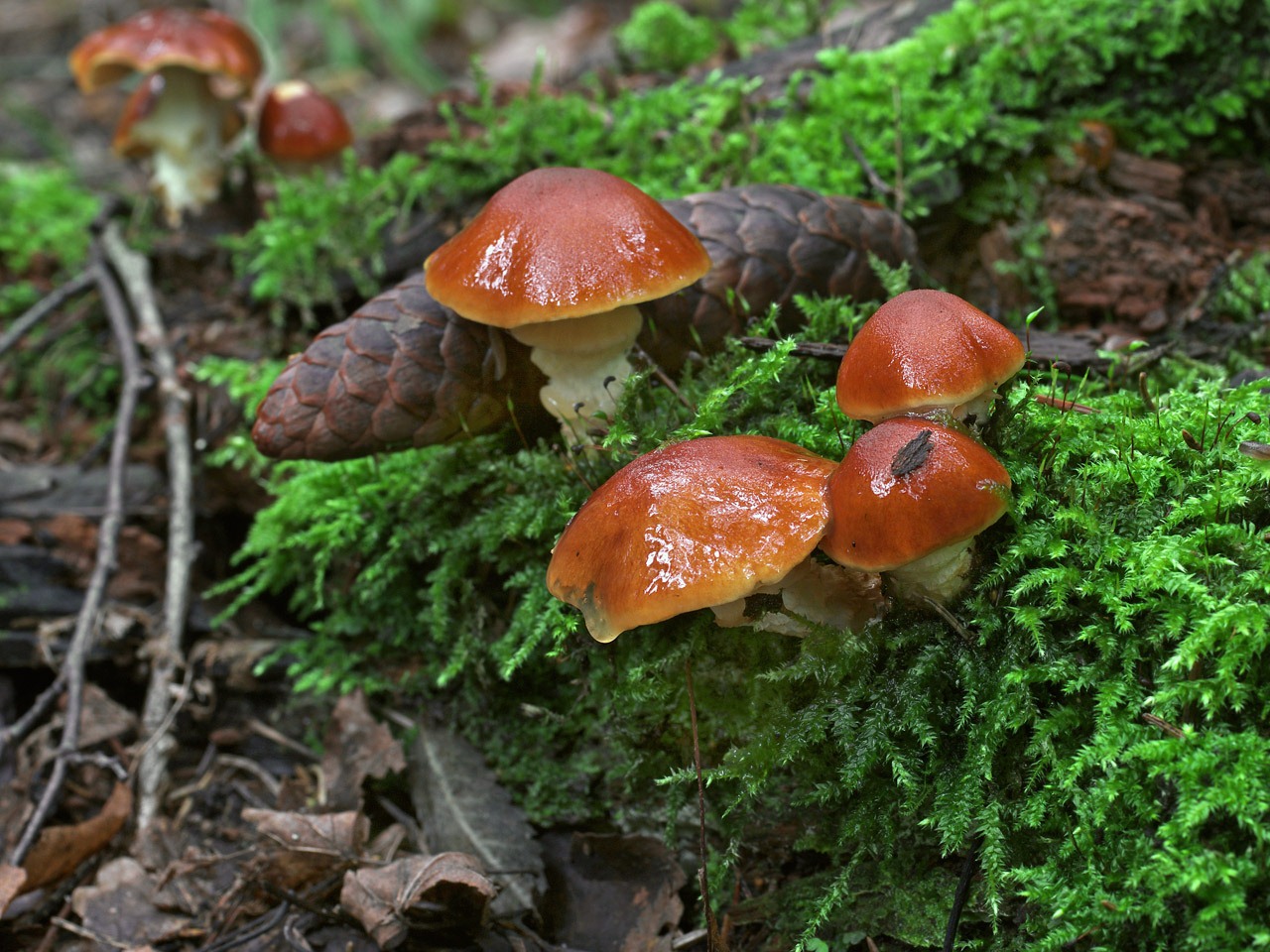Poisonous and inedible species of fungus scaly
Carbon-loving flake (Pholiota highlandensis)
Inedible mushroom.
The diameter of the cap is 2-6 cm, the shape is convex, then convex-prostrate. The skin is orange-brown or ocher-brown in color with a light edge, the surface is sticky, shiny, scaly. The pulp is thin, yellowish-brown in color, the taste and smell are not expressed. The leg is 3-6 cm high, 0.4-0.8 cm in diameter, cylindrical, thickens towards the base. Above it is yellowish, below it is dark brown, scaly.
Distributed in the northern temperate zone, grows in groups from June to early winter.
Fire scales (Pholiota flammans)
Inedible mushroom.
The diameter of the cap is 2.5-7 cm, the shape is hemispherical or conical in a young mushroom, with age it becomes convex and plano-convex, the edge is bent. The surface is covered with dry bright yellow scales, slimy, yellow-orange in color. The pulp is yellow-orange, brownish in the stem, has an earthy odor, the taste is insipid or bitter. The leg is 3-7 cm high, up to 1 cm thick, in mature mushrooms it is hollow, with a ring, below the ring it is covered with bright yellow scales.
The species is widespread in Eurasia; it grows on the dead wood of coniferous trees.
False doubles
The adhesive foliot has a number of counterparts. The differences between them can be seen in the photo. There is an external similarity with gum-bearing scaly with a beige cap and a fibrous, olive-brown stem.
The second double is a mucous foliot. It is distinguished by a larger cap (5-10 cm) of brown or yellow color, which is covered with mucus only in rainy weather.
Multicolor flake is often confused with a sticky foliot. It bears fruit in late autumn and is also covered in mucus. The cap of young mushrooms is pink, but the color is lost over time.
Dangerous doubles are described in more detail in the table:
| View | Description |
Long-legged False Foam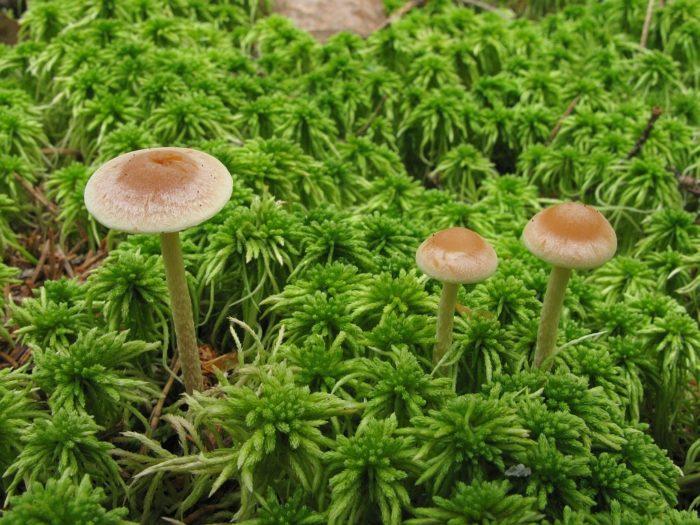 |
The cap is 1–3.5 cm in diameter, yellow, with remnants of a bedspread and grayish plates. In the rain, a layer of mucus appears on it. The leg is very thin, with a yellowish tinge. |
Pseudo-foil seroplate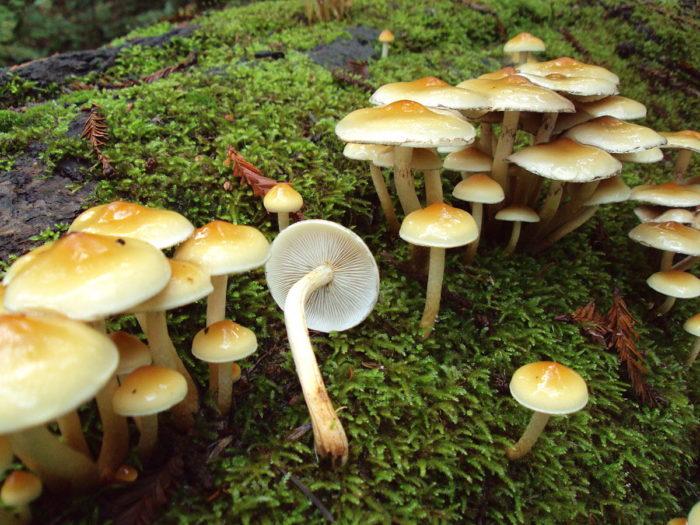 |
The yellowish or brownish cap has a diameter of 2.5–6 cm. The hymenophore is gray or bluish. The leg is rusty brown at the bottom, the length is up to 10 cm. |
Sulfur-yellow false foam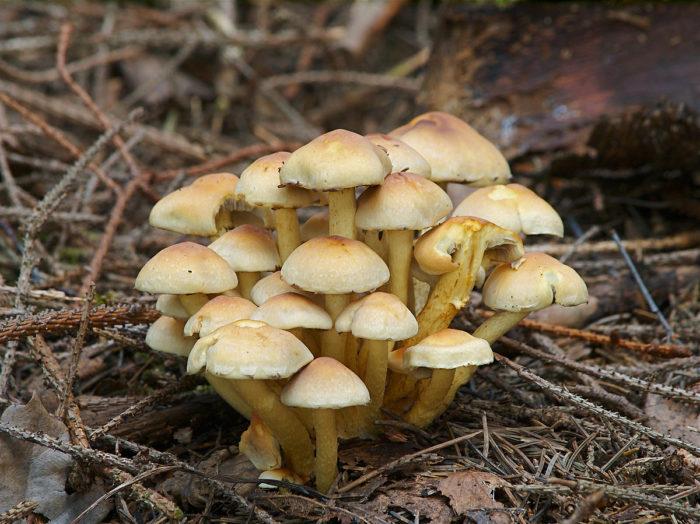 |
Fruit bodies grow in concretions. Hat 3–7 cm in diameter, color: sulfur-yellow or greenish with a reddish or brownish center. The leg is 5–12 cm high. Pronounced bitter taste. |
Sticky scales (Pholiota lenta)
or
External description
Hat: in youth, the cap of the mushroom has a convex shape, then it becomes prostrate. In the central part there is often a blunt tubercle, accentuated by color. The surface of the cap is whitish in young mushrooms, then the cap acquires a clay-yellow color. The tubercle in the central part of the cap has a darker shade. The surface of the cap is very slimy, even in dry weather. The cap is covered with tightly pressed, often inconspicuous scales. Scraps of the bedspread are often visible along the slightly tucked edges of the cap. In rainy, humid weather, the surface of the cap becomes slimy.
Flesh: The bonnet is characterized by a watery flesh of a light cream color. The pulp has an expressionless mushroom smell and practically no taste.
Plates: adherent, frequent plates in young mushrooms of a light clay color, in mature mushrooms, under the influence of ripened spores, the plates become rusty-brown. In his youth, the plate is hidden by a cobweb veil.
Spore powder: brown.
Leg: cylindrical leg, up to 8 cm high. No more than 0.8 cm thick. The leg is often curved, which is due to the growing conditions of the mushroom. Inside, the leg is made or solid. In the center of the cap there are remnants of the bedspread, which visually divide the leg into two areas. In the upper part, the leg is light creamy, smooth.In the lower part, the leg is covered with large flaky white scales. The flesh of the leg is more fibrous and tough. At the base, the flesh is reddish-brown, slightly lighter above, closer to yellowish color.
Spreading
Glutinous scales are considered a late fungus. The fruiting period begins in autumn and ends with the first frost in November. It is found in mixed and coniferous forests, on the remains of spruces and pines. It is also found on the soil near the stumps. Grows in small groups.
Similarity
The uniqueness of the fungus Scaly sticky is late fruiting and a very slimy, sticky cap. But, nevertheless, there is one species similar to sticky scales, with the same slimy fruit bodies, and this species bears fruit just as late.
Edibility
Glutinous scales - an edible mushroom, but due to its slimy appearance, it is not appreciated in mushroom cooking. Although eyewitnesses claim that this is just a disguise and the mushroom is not only edible, but also quite tasty.
Video about the mushroom Scaly sticky:
Note: It should be noted that not every slimy mushroom looks untidy and repulsive. Despite its obvious stickiness, Pholiota lenta is neat and pretty enough.
Description of golden scales
The diameter of the cap of these mushrooms reaches really king size - from 5 to 20 centimeters. The shape of the cap is initially broadly bell-shaped, but with age it changes to a flat-round one. The color of the cap is rusty yellow or dirty golden.
Flaky reddish scales are scattered over the entire surface of the cap. The plates of golden scales are wide, adherent to the stem with teeth, the color of the plates is at first light straw, but as it ripens, it becomes olive brown. The flesh is whitish-yellow.
The leg is 7-10 centimeters long and 1-1.5 centimeters in diameter. The leg is dense, yellow-brown in color with rusty-brown scales. There is a fibrous ring on the leg, which disappears with age.
Places of growth and fruiting period of golden scales
These mushrooms grow in large groups. They settle on tree trunks or next to them. Golden scales bear fruit from August to September. In the Primorsky Territory, they are harvested from May to September.
Royal mushrooms settle on the trunks of deciduous trees, preferring alder, willow, less often birch stumps. And sometimes they are found in coniferous forests and swampy areas. Golden scales, like ordinary mushrooms, grow in families.
The first caps of golden scales appear in mid-July, and fruiting continues until mid-October. Due to the rare appearance of golden scales, they are confused with false agarics that grow in the same places.
The use of royal honey mushrooms in cooking
Ashy flakes are edible mushrooms. Before use, they should be pre-boiled for 20 minutes. They have excellent taste. These mushrooms are used in salads and main dishes. Scales go well with fried potatoes. In addition, they are used to make preparations for the winter.
Scales collected in coniferous forests differ from scales grown in deciduous forests, they have a bitter taste. Therefore, they are more suitable for pickling and salting. Also, these mushrooms are great for freezing and drying.
Golden scales are a source of vitamin C, E and PP. They also contain magnesium, phosphorus, potassium, calcium, iron and sodium. The calorie content of royal mushrooms is 22 calories per 100 grams.
But, despite the spread of golden scales and its good recognition, these mushrooms are harvested not so often. This is due to the fact that few people know these mushrooms. Only true connoisseurs and gourmets of mushroom delicacies put them on a par with autumn mushrooms.
Other mushrooms of this genus
Scaly mucosa is a conditionally edible mushroom. At a young age, the shape of the cap is bell-shaped, and as it grows, it becomes prostrate or slightly concave; in adulthood, the edges of the cap rise slightly.The color of the cap is yellowish or bright brown, the central part is usually darker. In rainy weather, the pulp becomes slimy-sticky. The diameter of the cylindrical leg is approximately 1 centimeter, and its length reaches 10 centimeters. At first, the leg is cotton-like, and over time it becomes almost hollow. There is a ring on the leg, but it quickly disappears.
Slimy scales grow on decayed wood. These mushrooms bear fruit from August to October.
Scale cinder or coal-loving has a cap from hemispherical to prostrate shape. The diameter of the cap ranges from 2 to 6 centimeters. The color is heterogeneous orange-brown. In wet weather, the cap becomes mucous. Often the edges of the cap are covered with scraps of bedspread. The lower part of the leg is covered with brown fibers, while the upper part is lighter.
The diameter of the leg is 1 centimeter and the height reaches 6 centimeters. The trace from the ring on the leg is almost invisible.
Cinder flakes begin to occur in May and bear fruit until October with variable frequency. These mushrooms settle on burnt wood and old fireplaces. Scale scales are considered inedible.
Description and classification
The most popular and widespread on the territory of the CIS countries are edible and golden types of scales. Hybrids are also distinguished:
- alder;
- ordinary;
- cinder.
Edible scales have a fruiting body, in which a small rounded cap and a low leg are distinguished. The top is orange in color, covered with a small layer of mucus. It grows both in artificially created conditions and in the wild.
The Japanese use it in their national cuisine. The golden scaly has a cap 20 cm in diameter, which in young specimens differs in slightly upward curved edges. It has a tubercle in the center. Its color can vary from yellow to brown. The top is dense in structure. The hat becomes slippery when the air humidity is high. In dry weather, it has a shiny surface and leaks.
In unripe fruits, the pulp is rather dense in structure, with a yellow tint. The leg is strong and does not exceed 15 cm in height. The common scaly belongs to the category of conditionally edible mushrooms. This is the most common and popular type. It is bred by Japanese farmers for sale.
In the wild, this species grows in temperate climates. For normal growth, he needs light. The fungus appears on the surface as soon as the snow melts. The fruiting season lasts until October. It grows in rare forests, small parks. It became widespread in Eastern and Western Europe.
Mushroom varieties:
- Hairy scales parasitizes on woody words. It grows in small groups. Her fruiting season lasts from mid-August to November. The cap reaches 10 cm in diameter, convex in shape. Its surface is covered with protruding scales. The pulp is firm and homogeneous. This mushroom tastes like a radish. The leg reaches a height of 12 cm. The mushroom is considered to be edible, it is ranked in the 4th category. However, it is not used in cooking, as it has a bitter taste.
- Poplar scales grow on dry trunks and stumps. The mushroom has spread in the Primorsky Territory and Siberia. It can also be found in forests in the European part of Russia. The diameter of the cap is 15 cm, it is covered with white fibers and has a brown color. The leg is long. Such a mushroom grows from early August to late September. For growth, he prefers birch, aspen, poplar. The mushroom is inedible.
- The fiery scale has a lemon or bright yellow cap and reaches about 10 cm in diameter. Its shade is darker in the center, and large monochromatic scales are located along the edges. In young fruits, the plates are covered with a small mesh, differing in brown color. The pulp is slightly bitter, but has a pleasant aroma. This variety grows in the temperate zone of Russia. Prefers hardwood base. Can be found on mossy soil and tree stumps.This mushroom is not used in cooking because of its bitter taste.
- Scale Alkhovaya grows in groups, adapts well to the substrate near tree trunks. Most often, she prefers birch. Fruiting begins in August and lasts until September. The hat reaches 5 cm in diameter, is small, yellow and has brown scales. The mushroom is inedible.
- Cinder flakes have a hemispherical cap. It unfolds somewhat as it matures. The top of the fruit reaches 6 cm in diameter and is characterized by a reddish-brown color. The surface is covered with mucus and has small fibrous scales. The pulp is light yellow and firm. This mushroom has no smell or taste. The plates are adherent, frequent. The fruiting season is from May to September. It grows mainly in places where fire is made.
Definitioner
- Basidia (Basidia)
-
Lat. Basidia. A specialized structure of sexual reproduction in fungi, inherent only in Basidiomycetes. Basidia are terminal (end) elements of hyphae of various shapes and sizes, on which spores develop exogenously (outside).
Basidia are diverse in structure and method of attachment to hyphae.
According to the position relative to the axis of the hypha, to which they are attached, three types of basidia are distinguished:
Apical basidia are formed from the terminal cell of the hypha and are located parallel to its axis.
Pleurobasidia are formed from lateral processes and are located perpendicular to the axis of the hypha, which continues to grow and can form new processes with basidia.
Subasidia are formed from a lateral process, turned perpendicular to the axis of the hypha, which, after the formation of one basidium, stops its growth.
Based on morphology:
Holobasidia - unicellular basidia, not divided by septa (see Fig. A, D.).
Phragmobasidia are divided by transverse or vertical septa, usually into four cells (see Fig. B, C).
By type of development:
Heterobasidia consists of two parts - hypobasidia and epibasidia developing from it, with or without partitions (see Fig. C, B) (see Fig. D).
Homobasidia is not divided into hypo- and epibasidia and in all cases is considered holobasidia (Fig. A).
Basidia is the place of karyogamy, meiosis and the formation of basidiospores. Homobasidia, as a rule, is not functionally divided, and meiosis follows karyogamy in it. However, basidia can be divided into probasidia - the site of karyogamy and metabasidia - the site of meiosis. Probasidium is often a dormant spore, for example in rust fungi. In such cases, probazidia grows with metabasidia, in which meiosis occurs and on which basidiospores are formed (see Fig. E).
See Karyogamy, Meiosis, Gifa.
- Pileipellis
-
Lat. Pileipellis, skin - differentiated surface layer of the cap of agaricoid basidiomycetes. The structure of the skin in most cases differs from the inner flesh of the cap and may have a different structure. The structural features of pileipellis are often used as diagnostic features in descriptions of fungi species.
According to their structure, they are divided into four main types: cutis, trichoderma, hymeniderma and epithelium.
See Agaricoid fungi, Basidiomycete, Cutis, Trichoderma, Gimeniderm, Epithelium.
- Trichoderma (Trichoderma)
-
The type of cap skin, usually consists of straight, septate elements located more or less perpendicular to the surface and laid both at the same and at different levels; the ends of the hyphae can be morphologically modified and represent dermatocystids. The surface of the cap is velvety to almost felt.
Lat. Trichoderm.
Trichoderma, in turn, is subdivided into intertwined trichoderma and irregular trichoderma.
Intertwined trichoderm (Intricate trichoderm) - trichoderm, consisting of intertwined hyphae, located not parallel to each other and forming a tomentose pubescence.
Irregular trichoderm - Trichoderma, consisting of irregularly branching hyphae.
See Dermatotsistida, Hypha, Septa.
- Cutis
-
The type of cap skin, consists of creeping non-gelatinized hyphae located parallel to the surface. The surface of the cap looks smooth.
Lat. Cutis.
Cm.Gifa.
Royal mushrooms or golden flake
The golden scales differ from the usual honey fungus in appearance, it is larger, on the cap there are small scales that resemble the needles of a hedgehog. In Japan, the mushroom is bred on rotten stumps, and in Russia, for some reason, mushroom pickers often do not trust it, not counting it as edible. It is better to collect royal mushrooms at the end of summer and the first half of October.
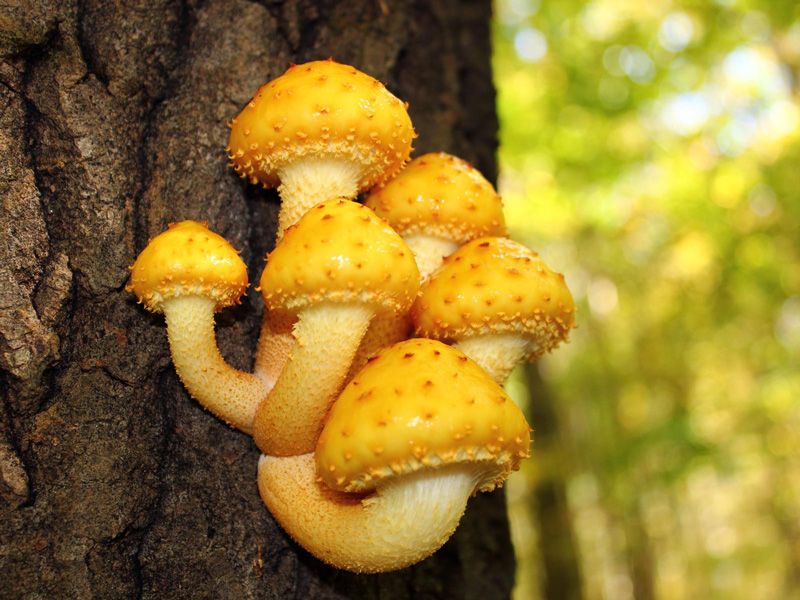
Description and characteristics of the mushroom
| Parameter | Characteristic |
| Hat | The diameter of young mushrooms is 5-10 centimeters, adults - 10-20. The hat is shirokokolokochatoy form, eventually becomes flat-round. Color - from yellow and bright red to golden. Around the entire area of the cap there are many red-colored scales that resemble flakes. |
| Leg | Length - 6-12 centimeters, diameter - 2 centimeters. Dense, with fleecy yellow or gold scales. There is a fibrous ring on it, which disappears over time. |
| LPs | Wide stem plates are dark brown in color. At first, their color is light straw, they darken only with time. |
| Pulp | Light yellow, has a pleasant smell. |
Where do golden scales grow and when to collect them?
The very season to go for these mushrooms is the end of August and mid-October. In the Primorsky Territory, where the climate is warmer, harvesting is possible from the end of May. Finding royal mushrooms is quite simple: they grow in a large family. But it is precisely because of the timing of collection that they are often confused with poisonous counterparts.
The main way to distinguish edible mushrooms from false ones is to see where they grow. Good mushrooms grow on dead trees.
Mr. Dachnik warns: dangerous doubles
Edible royal honey is difficult to confuse with poisonous counterparts, due to its red color and sharp needle-like scales. However, novice fungi can make a mistake and collect golden skyrim instead of scales:
- Scale alder or moth (Pholiota alnicola). The main difference is its small size. The length of the legs never exceeds 8 centimeters, the diameter of the cap (yellow) is 6. The thickness is only 0.4 centimeters. Bitter and smells unpleasant.
- Fiery scales (Pholiota flammans). It has a very bright color and regular-shaped scales (a tone lighter than that of an edible mushroom). This false honey fungus is easy to identify by its habitat, unlike royal mushrooms that grow in families, it prefers solitude, it is found in mixed and coniferous forests. It is not poisonous, but you should not use it in dishes.
- Cinder scale (Pholiota highlandensis). It is distinguished by its modest size and a dark brown hat, strewn with fleecy scales. The surface of the cap and stem is often covered with mucus. A favorite place of this mushroom is burnt wood.
- Scaly mucosa (Pholiota lubrica). Refers to conditionally edible. The cap is large, but there are few scales and they are always light. The rings are missing from the start.
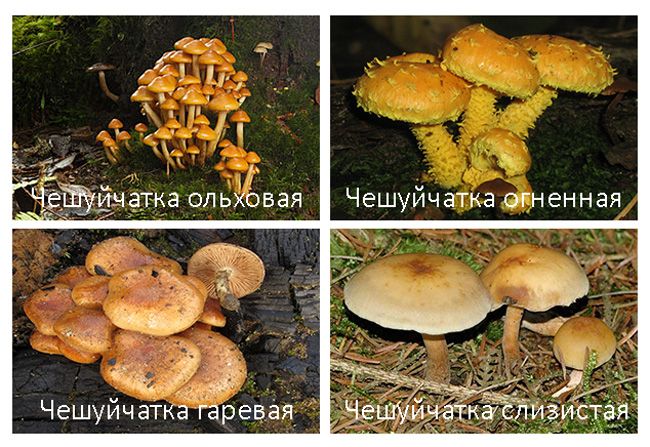
Calorie content, benefits and harms of royal mushrooms
Nutritional value per 100 grams: 21 Kcal.
Scale golden contains a lot of phosphorus, calcium, iron and magnesium. Strengthens the immune system, normalizes blood composition (increases the number of erythrocytes (red cells) in the blood), improves the functioning of the thyroid gland, and replenishes the supply of potassium. In folk medicine, these mushrooms are used to treat diabetes mellitus, thrombophlebitis, and anemia.

When cooking, honey mushrooms must be boiled, after which they are stewed or fried. For most dishes, hats are used; it is better to marinate the legs.

